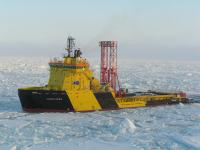Ocean-drilling scientists cite history of Arctic climate change

Swedish drilling vessel, Vidar Viking, led the Arctic Coring Expedition, when scientists set out to retrieve subseafloor sediment records to support their investigations into climate change. Credit: IODP/ECORD Science Operator
Key findings published in Nature
A group of ocean-drilling research scientists that explored the Arctic Ocean subseafloor in Fall 2004 have released new findings in a report to be published in Nature on June 1. The report, supported by Integrated Ocean Drilling Program (IODP) research operations, contains analyses of subseafloor sediment samples gathered from 430 meters beneath the Arctic Ocean, near the North Pole. To recover the sediments that yielded the prehistoric climate records, the research team needed to manage three ice-breakers, one of which was equipped with a drill rig. The sediment records were recovered from the Lomonsov Ridge, in water about 1000 meters deep.
The IODP Arctic Coring Expedition (ACEX) scientists report their key findings in Nature:
- Evidence of ice in the Arctic Ocean was found much earlier than formerly believed, about 45 million years ago;
- At one time about 55 million years ago, Arctic temperatures rose to subtropical levels (about 23 degrees Centigrade);
- At one time about 49 million years ago, the Arctic was green, with fresh surface water and large amounts of fern covering the water, at least in summer months.
Expedition co-chief scientist Kathryn Moran, University of Rhode Island, notes that the overall age span of the sediments recovered was a few million years longer than was expected to retrieve. Such successful recovery was possible, in large part, due to strategic planning in anticipation of strenuous ice management. Planners had predicted that the three-vessel fleet could maintain the drilling vessel’s station for up to two full days, yet the station-keeping achievements went far beyond this expectation. The Vidar Viking was kept on location in multi-year ice for nine days–a landmark feat that empowered ACEX scientists to sustain their ocean-drilling explorations for a significant period. “The scientific community benefited from our extraordinary ice management efforts–we are the first to study full geologic records from the Arctic Ocean,” said Moran.
Moran’s colleague, co-chief scientist Jan Backman, a professor at Stockholm University, Sweden, also recalls the challenging research conditions. “At times, the drill site was covered with ice two- to three-meters thick. We encountered an ice flow of multi-year ice, harder and denser than ice from just one Arctic winter; it was like driving into a brick wall.” The upper sections (160 meters) of retrieved sediments indicate prevailing ice conditions during the last 14-16 million years.
Media Contact
More Information:
http://www.iodp.orgAll latest news from the category: Earth Sciences
Earth Sciences (also referred to as Geosciences), which deals with basic issues surrounding our planet, plays a vital role in the area of energy and raw materials supply.
Earth Sciences comprises subjects such as geology, geography, geological informatics, paleontology, mineralogy, petrography, crystallography, geophysics, geodesy, glaciology, cartography, photogrammetry, meteorology and seismology, early-warning systems, earthquake research and polar research.
Newest articles

Scientists transform blood into regenerative materials
… paving the way for personalized, blood-based, 3D-printed implants. Scientists have created a new ‘biocooperative’ material based on blood, which has shown to successfully repair bones, paving the way for…

A new experimental infection model in flies
…offers a fast and cost-effective way to test drugs. Researchers at the Germans Trias i Pujol Research Institute and Hospital have reinforced their leading role in infectious disease research by…

Material developed with novel stretching properties
KIT researchers produce metamaterial with different extension and compression properties than conventional materials. With this material, the working group headed by Professor Martin Wegener at KIT’s Institute of Applied Physics…



